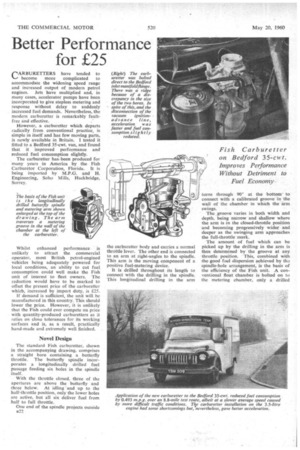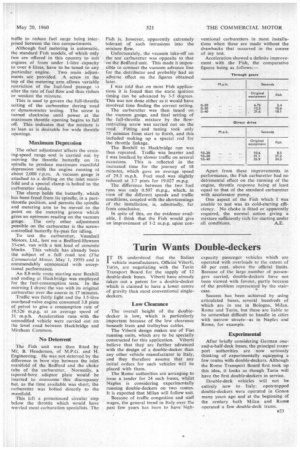Better Performance
Page 56

Page 57

If you've noticed an error in this article please click here to report it so we can fix it.
for £25
ARBURETTERS have tended to become more complicated to accommodate the widening speed range and increased output of modern petrol engines. Jets have multiplied and, in many cases, accelerator pumps have been incorporated to give stepless metering and response without delay to suddenly increased fuel demands. Nevertheless, the modern carburetter is remarkably faultfree and effective.
However, a carburetter which departs radically from conventional practice, is simple in itself and has few moving parts, is newly available in Britain. I tested it fitted to a Bedford 35-cwt. van, and found that it improved performance and reduced fuel consumption slightly.
, The carburetter has-been produced for many years in America by the Fish Carburetor Corporation, Florida. It is being imported by M.P.G. and H. Engineering, Soho Mills, Hackhridge, Surrey, Whilst enhanced performance is unlikely to attract the commercial operator, most British petrol-engined vehicles being adequately powered for local conditions, an ability to cut fuel consumption could well make the Fish unit of interest to fleet owners, The reduction would have to be marked to offset the present price of the carburetter which, increased by import duty, is £25.
If demand is sufficient, the unit will be manufactured in this country. This should Tower the price. However, it is unlikely that the Fish could ever compete on price with quantity-produced carburetters as it relies on close tolerances for its working surfaces and is, as a result, practically hand-made and extremely well finished.
Novel Design
The standard• Fish carburetter, shown in the accompanying drawing, comprises a straight bore containing a butterfly throttle. The butterfly spindle incorporates a longitudinally drilled fuel passage feeding six holes in the spindle itself, With the throttle closed, three of the apertures arc above the butterfly and three below. At idling and up to the half-throttle position, only the lower holes are active, but all six deliver fuel from half to full throttle.
One end of the spindle projects outside 11/1
the carburetter body and carries a normal throttle lever. The other end is connected to an arm at right-angles to the spindle. This arm is the moving component of a positive fuel-metering device.
It is drilled throughout its length to connect with the drilling in the spindle. This longitudinal drilling in the arm turns through 90° at the bottom to connect with a calibrated groove in the wall of the chamber in which the arm swings.
The groove varies in both width and depth, being narrow and shallow where the arm is in the closed-throttle position and becoming progressively wider and deeper as the swinging arm approaches the full-throttle mark.
The amount of fuel which can he picked up by the drilling in the arm is thus determined by the groove at any throttle position. This, combined with the good fuel dispersion achieved by th..r, spindle-hole arrangement, is the basis of the efficiency of the Fish unit. A conventional float chamber is bolted on to the metering chamber, only a drilled baffle to reduce fuel surge being interposed between the two compartments: Although fuel metering is automatic, the standard Fish models, of which only two are offered in this country to suit engines of from under 1-litre capacity to over 4 litres, have to be tuned to any particular engine. • Two main adjustments are provided. A screw in the top of the metering arm allows variable restriction of the fuel-feed passage io alter the rate of fuel flow and thus richer' or weaken the mixture.
This is used to govern the full-throttle setting of the carburetter during road or dynamometer testing. The screw is turned clockwise until power at the maximum throttle opening begins to fall off. This indicates that the mixture is as lean as is desirable for wide throttle openings.
Maximum Depression The other adjustment -affects the cruising-speed range -and is carried out by moving the throttle butterfly on its spindle to produce maximum manifold depression with the engine running at about 2,000 r.p.m. A vacuum gauge is attached to a drilling on the inlet manifold and a special clamp is bolted to the carburetter intake.
The clamp holds the butterfly, which has been freed from its spindle, in a partthrottle position, and permits the spindle and metering arm to he moved to the point on the metering groove which gives an optimum reading on the vacuum gauge. The only other adjustment possible on the carburetter is the screwcontrolled butterfly by-pass for idling.
To test the carburetter, Vauxhall Motors, Ltd., tent me a Bedford-Hawson 35-cwt. van with a test load of concrete blocks. This vehicle has already been the subject of a full road test (the Commercial Motor, May 1, 1959) and is commendably economical with exceptional performance.
An 8.8-mile route starting near Boxhill and ending at Hackbridge was employed for the fuel-consumption tests. " In the morning I drove the van with its original carburetter over the course in 17 minutes.
Traffic was fairly light and the 3.5-litre overhead-valve engine consumed 3.8 pints of petrol to give a consumption rate of 18.526 m.p.g. at an average speed of 31 m.p.h. Acceleration runs with the unmodified vehicle were carried out on the level road between Hackbridge and Mitcham Common.
No Deterrent The Fish unit was then fitted by Mr. B. Henderson, of M.P.G. and H. Engineering. He was not deterred by the difference in bore size between the inlet manifold of the Bedford and the choke tube of the carburetter. Normally, a tapered-bore adaptor plate would be inserted to overcome this discrepancy hut, as the time available was short, the carburetter was bolted directly to the manifold.
This left a pronounced circular step below the throttle which would have worried most carburation specialists. The
Fish is, however, apparently extremely tolerant of such intrusions into the mixture flow.
Unfortunately, the vacuum take-off on the test carburetter was opposite to that on the Bedford unit. This made it impossible to connect the vacuum advance line for the distributor and probably had an adverse effect on the figures obtained later.
I was told that on most Fish applications it is found that the static ignition timing can be advanced by 3-5 degrees. This was not done either as it would have involved time finding the correct setting.
The carburetter was then tuned on the vacuum gauge, and final setting of the full-throttle mixture by the flowrestricting screw was carried out on the road. Fitting and tuning took only 75 minutes from start to finish, and this included making up a special rod for the throttle linkage.
The Boxhill to Hackbridge run was then repeated. Traffic was heavier and I was baulked by slower traffic on several occasions. This is reflected in the increased time for the journey of 18 minutes, which gave an average speed of 29.3 m.p.h. Fuel used was slightly reduced at 3.7 pints for 19.027 m.p.g.
The difference between the two fuel runs was only 0.507 m.p.g., which, in view of the different speeds and traffic conditions, coupled with the shortcomings of the installation, is, admittedly, far from conclusive.
Tn spite of this, on the evidence available, I think that the Fish would give an improvement of 1-2 m.p.g. upon con ventional carburetters in most installations when these arc made without the drawbacks that occurred in the course of my test.
Acceleration showed a definite improvement with the Fish, the comparative figures being as follows;—
Apart from these improvements in performance, the Fish carburetter had no detrimental effect on the running of the engine, throttle response being at least equal to that of the standard carburetter with accelerator pump.
One aspect of the Fish which I was unable to test was its cold-starting efficiency. No choke is fitted or apparently required, the normal action giving a mixture sufficiently rich for starting under
all conditions. A.E.




















































































































